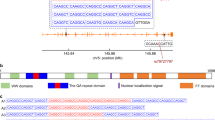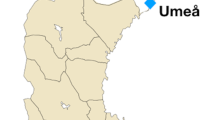Abstract
An expanded polyglutamine stretch in the huntingtin protein has been identified as the pathogenetic cause of Huntington's disease (HD). Although the length of the expanded polyglutamine repeat is inversely correlated with the age-at-onset, additional genetic factors are thought to modify the variance in the disease onset. As linkage analysis suggested a modifier locus on chromosome 4p, we investigated the functional relevance of S18Y polymorphism of the ubiquitin carboxy-terminal hydrolase L1 in 946 Caucasian HD patients. In this group, the allelic variation on locus S18Y is responsible for 1.1% of the variance in the HD age-at-onset, and the rare Y allele is associated with younger-aged cases.
Similar content being viewed by others
References
Haigh B, Huq M, Hayden MR. Huntington disease. In: GeneReviews (online). Available at:http://www.geneclinics.org/servlet/access?id=8888891&key=28UhX7Ix0tj-L&gry=&fcn=y&fw=uoW9&filename=/profiles/huntington/index.html. Cited May 25, 2004
Stine OC, Pleasant N, Franz ML, Abbott MH, Folstein SE, Ross CA (1993) Correlation between the onset age of Huntington's disease and length of the trinucleotide repeat in IT-15. Hum Mol Genet 2:1547–1549
Brinkman RR, Mezei MM, Theilmann J, Almqvist E, Hayden MR (1997) The likelihood of being affected with Huntington disease by a particular age, for a specific CAG size. Am J Hum Genet 60:1202–1210
Nazé P, Vuillaume I, Destée A, Pasquier F, Sablonnière B (2002) Mutation analysis and association studies of the ubiquitin carboxy-terminal hydrolase L1 gene in Huntington's disease. Neurosci Lett 328:1–4
Maraganore DM, Lesnick TG, Elbaz A, Chartier-Harlin MC, Gasser T, Krüger R, Hattori N, Mellick GD, Quattrone A, Satoh J, Toda T, Wang J, Ioannidis JP, de Andrade M, Rocca WA, the UCHL1 Global Genetics Consortium (2004) UCHL1 is a Parkinson's disease susceptibility gene. Ann Neurol 55:512–521
Maraganore DM, Farrer MJ, Hardy JA, Lincoln SJ, McDonnell SK, Rocca WA (1999) Case-control study of the ubiquitin carboxy-terminal hydrolase L1 gene in Parkinson's disease. Neurology 53:1858–1860
Wintermeyer P, Krüger R, Kuhn W, Müller T, Woitalla D, Berg D, Becker G, Leroy E, Polymeropoulos M, Berger K, Przuntek H, Schöls L, Epplen JT, Riess O (2000) Mutation analysis and association studies of the UCHL1 gene in German Parkinson's disease patients. Neuroreport 14:2079–2082
Li J-L, Hayden MR, Almqvist EW, Brinkman RR, Durr A, Dodé C, Morrison PJ, Sochowersky O, Ross CA, Margolis RL, Rosenblatt A, Gómez-Tortosa E, Cabrero DM, Novelletto A, Frontali M, Nance M, Trent RJA, McCusker E, Jones R, Paulsen JS, Harrison M, Zanko A, Abramson RA, Russ AL, Knowlton B, Djoussé L, Mysore JS, Tariot S, Gusella MF, Wheeler VC, Atwood LD, Cupples LA, Saint-Hilaire M, Cha J-HJ, Hersch SM, Koroshetz WJ, Gusella JF, MacDonald ME, Myers RH (2003) A genome scan for modifiers of age at onset in Huntington disease: the HD MAPS study. Am J Hum Genet 73:682–687
Djoussé L, Knowlton B, Hayden MR, Almqvist EW, Brinkman RR, Ross CA, Margolis RL, Rosenblatt A, Durr A, Dode C, Morrison PJ, Novelletto A, Frontali M, Trent RJA, McCusker E, Gómez-Tortosa E, Cabrero DM, Jones R, Zanko A, Nance M, Abramson RA, Suchowersky O, Paulsen JS, Harrison MB, Yang Q, Cupples LA, Mysore J, Gusella JF, MacDonald ME, Myers RH (2004) Evidence for a modifier of onset age in Huntington disease linked to the HD gene in 4p16. Neurogenetics 5:109–114
Liu Y, Fallon L, Lashuel HA, Liu Z, Lansbury PT Jr (2002) The UCH-L1 gene encodes two opposing enzymatic activities that affect á-synuclein degradation and Parkinson's disease susceptibility. Cell 111:209–218
Spillantini MG, Goedert M (2000) The á-synucleinopathies: Parkinson's disease, dementia with Lewy bodies, and multiple system atrophy. Ann NY Acad Sci 920:16–27
Acknowledgements
This study was supported by the GeNeMove Network for hereditary movement disorders financed by BMBF. The Polish part of the study performed in the Department of Genetics, Institute of Psychiatry and Neurology was supported by the State Committee for Scientific Research PBZ-KBN-042/P05/2001. A. Nazli Basak's research is sponsered by Bogazici University Research Funds and by Suna-Inan Kirac Foundation. Special thanks to K. Dietz, Department of Medical Biometry, University of Tübingen, Germany for statistical advice. Experiments comply with the current laws in Germany.
Author information
Authors and Affiliations
Corresponding author
Rights and permissions
About this article
Cite this article
Metzger, S., Bauer, P., Tomiuk, J. et al. The S18Y polymorphism in the UCHL1 gene is a genetic modifier in Huntington’s disease. Neurogenetics 7, 27–30 (2006). https://doi.org/10.1007/s10048-005-0023-z
Received:
Accepted:
Published:
Issue Date:
DOI: https://doi.org/10.1007/s10048-005-0023-z




